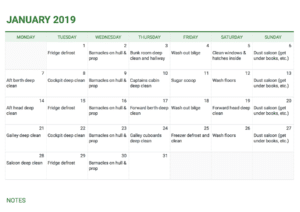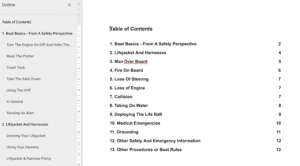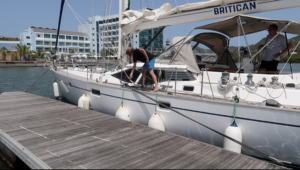The boat cleaning tasks template might seem like a simple spreadsheet but you’ll be amazed by its effectiveness. Whether it’s just you and your partner or you and a group of guests, you can use this tasks template to provide each occupant with the responsibilities necessary to keep your boat clean and tidy.
The boat cleaning calendar is far from simplistic and takes quite a bit of effort to keep it going. Some jobs are not too laborious whereas others are a real bore. Make a commitment to yourself to enforce that the calendar job gets done each day. After a couple of months, you’ll reap the benefits of a clean boat and reduction in monstrous cleaning jobs.
Learn all you need to know and how to use a life raft in less than six minutes!
Members only! As mentioned in my article, Three Things That All Liveaboards Must Know, I offer a free copy of the Britican Boat Safety Manual for members to use. This 15-page document will provide a template for your own boat safety manual. You’ll have to chop and change according to your own boat but the bulk of the information is standard.
The document covers a basic boat operating manual in addition to procedures for Man Over Board, fire, steering malfunctions, engine failure, collision, taking on water, the location of all thru-hull fittings, how to deploy the life raft, medical emergencies, grounding, and other procedures and boat rules. This manual can be used if you’re getting your boat coded for chartering purposes or to simply have in your navigation desk as a reference for the crew, guests, and passengers.
Simon, Sienna, my father-in-law and I just recorded a video message for you. We filmed it on the water across from Portsmouth, UK located at the bottom of England (where Simon’s dad lives). Watch it now…
In the last week I’ve had three ambulance rides, a trip in a private plane, visited two hospitals – staying in one for five days and a commercial flight from the Caribbean to London, England where I’m now situated. Is it time to stop living the dream?
Why do I think it happened in the first place? Has this experience caused me to reevaluate whether my family and I should continue with the cruising life? What do I think about people that have health conditions that do want to go cruising? What’s the the future for sailing Britican? Find out more here…
I could sense the doctor was afraid. I suppose I got a glimpse into the psychic sense that dogs have. Our four legged friends feel or smell fear – don’t they? The doctor looked and acted confident but I knew he wished he wasn’t standing above me. He wished someone else was in his place.
After saying that he needed to act fast, the Doctor proceeded to put a drug into the needle port placed on the top of my hand. At the last minute he pulled back and said, ‘let me check something.’ The doctor started checking my pulse on my legs, under my knees, on my wrist. He then said, hold on and walked out.
I could see the drug on the counter. I was in so much discomfort that I just wanted him to inject it. Without knowing what was going on I Knew (with a capital K) that that drug was going to either help me or perhaps kill me.
After having my heart beat at 233 beats per minute for two hours I was getting ready to give up.
Many people ask me how I enjoy the holidays as a live aboard cruiser. Well…this festive season marks our fourth year on the boat and fifth year owning her. Looking back, we have celebrated Christmas in various countries with a variety of friends and family. Amazingly, each year Santa seems to get the Lat and Long that I send him, much to Sienna’s delight.
Most boat crashes and hull crunches happen when docking and leaving a dock. Why? There’s a variety of reasons. Some new (and experienced) boat owners misread the elements (wind, tide, current). Other’s misjudge the space available. And it’s very common for inexperienced marina dock hands or crew to mess things up with the lines. Boat handling leaving a dock is a key skill to learn.
Unfortunately, once a new boat owner has a crunch it can be quite a setback.
Sure, there’s a cost associated to a scratch or hole but the real issue is with confidence. We’ve met many new boat owners that have a few small accidents and decide to call it a day. Take a look at all the boats you’ll find in a marina on a perfect sailing day – many people want to live the dream, buy access to the dream and then lose steam when it comes to actually making the dream happen (leaving the dock).
The crazy thing is that there are very safe and easy steps regarding boat handling leaving a dock.
In fact, the steps that we use make docking and leaving a dock look like a breeze – even for newbies. Like so many things with boat ownership, having a blueprint or a checklist can help you make a success out of it more times than not. Below you’ll find a video where Simon explains the procedure, we then demonstrate leaving a dock and we also provide an alternative. Furthermore, you’ll find the steps written below the video.
What’s the number one thing a boater should do in the hopes of preventing boat engine failure? To ensure routine engine checks are completed. On Britican, we do a series of routine engine checks before EVERY voyage. On the video below, Simon will show you how he completes each check.








